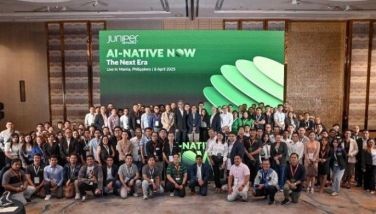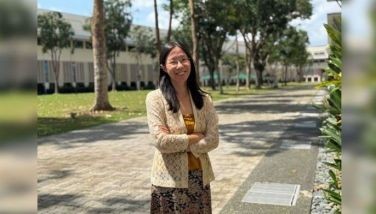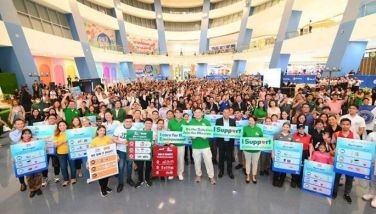Rhetoric of peace and shared progress
US President Donald Trump’s tariff pronouncements jolted economies around the world, heightening global anxiety and sparking fears of global trade war and recession all within the context of a post-pandemic global economy. China was the hardest hit, with Trump imposing a hefty 54 percent tariff – 34 percent on top of an already announced 20 percent – on Chinese imports. In retaliation, China announced a 34 percent tariff on US goods. Trump then threatened to escalate the trade conflict further with another 50 percent tariff on Chinese goods, potentially resulting in 104 percent tariff on certain products. Beijing is not backing down and has vowed to “fight to the end.”
While the world anxiously watches the unfolding US-China trade tensions, the consequences are already being felt across the world. Global markets plunged into turmoil following Trump’s announcement of sweeping tariffs on almost every nation. Asian stocks were hit as seen in their sharpest drop in decades. The ripple effects of Trump’s protectionist approach are far and wide, even haunting Southeast Asian markets.
Trump insisted that this tariff strategy will boost the US economy and protect American jobs. However, this “America First” policy of Trump has disrupted the global trading system, shaking highly diverse economies that are tightly integrated in supply chains particularly those from ASEAN – from manufacturing powerhouses like Vietnam to financial hubs such as Singapore.
As an ally of the US and an active trading partner of China, the Philippines again finds itself in an awkward and uncomfortable position of being caught in the middle of great power rivalries. This, as tensions rise in the Indo-Pacific with alarming headlines about a possible invasion of Taiwan by China under the watchful gaze of the US.
Adding fuel to the fire are the reportedly recent remarks in the media allegedly urging our troops to “prepare for war” and revealing plans to ramp up the acquisition of fighter jets, missiles and warships – stoking fears of a looming catastrophe.
China was, as expected, quick to react, expressing displeasure over these statements. It even warned the Philippines that “those who play with fire will burn themselves.”
This war rhetoric, both economic and political, has dominated headlines here and abroad. It not only fuels anxieties but also causes more geopolitical tensions.
One may ask – is it necessary to engage in this conflict? Would it be better to pursue peace instead?
In an era marked by global economic and political uncertainty, what we need most is not more fear, but a clearer vision for the future – one rooted in diplomacy, dialogue and strategic foresight.
The possible flashpoint over Taiwan and the West Philippine Sea prompts the Philippines to come to terms with the reality that economic entanglement with global powers China and the US can perhaps be best resolved with stronger diplomatic efforts. It is always better to dialogue and negotiate.
Tariffs may appear as economic tools, but these can easily be weaponized politically – increasing the risks for countries like ours to be pulled into conflicts. As a nation that is not a manufacturing powerhouse, we must recognize the profound impact such developments could have on our economy.
We cannot afford to join the chorus of war drums being played across the Pacific. Our role should not be that of an echo chamber for powerful allies, but that of a calm, reasoned voice advocating for peace in the region while pursuing economic diversification.
With the heightened trade friction caused by Trump’s tariffs, ASEAN countries including the Philippines should turn to diversification – strengthening market relations with regional players like Japan and South Korea, among others, to further improve regional economic resilience. ASEAN nations must strike a balance between protecting their own economies while maintaining international trade relationships with the global superpowers.
In terms of dealing with China, the pragmatic approach perhaps for the Philippines and neighboring Southeast Asian countries is to promote the rhetoric of peace through diplomacy. ASEAN has always stood strongest when it championed regional stability and pushed for solidarity and diplomacy as one.
The most constructive form of foreign policy we can pursue now is twofold: state-level diplomacy and people-to-people partnerships.
In view of the tariffs imposed, can we revisit and fast-track the implementation of agreements forged with the US, not to appease, but to establish economic interdependence and mutual respect?
In parallel, civil society, business chambers and cultural organizations must strengthen their collaborative efforts to promote trade, education and poverty alleviation.
The Management Association of the Philippines (MAP)’s proposal to swiftly establish an Economic Security Council to tackle the emerging challenges from global trade developments is both timely and crucial.
We need to continue to look for ways to work together to increase trade and commerce, to have joint entrepreneurial programs, to share each other’s resources in social development projects that address poverty, hunger, literacy and quality of life goals.
The ongoing efforts of the Federation of Filipino Chinese Chambers of Commerce and Industry Inc. (FFCCCII) are commendable, particularly their focus on mentoring small entrepreneurs in commerce and manufacturing – an essential step toward mutual prosperity.
Moving forward, dialogue and diplomacy should be our guiding principles, with military posturing taking a backseat. By embracing diplomacy, we not only foster coexistence but also avoid the risks of widespread economic and political regression.
It’s time to reject the rhetoric of war. Let us instead raise our voices in pursuit of the rhetoric of peace and bring forward narratives that emphasize cooperation, understanding and shared progress for all.
- Latest
- Trending


























